By Dave O’Malley
Over 260 families in Kitchissippi lost sons in wars of the 20th Century. During these wars, the death of a child was a heavy and lacerating blow to every family, but back then it was often drawn out for many months, revisited again and again as each layer of hope was stripped away after the first missing-on-operations telegram. Many would never know the manner of their deaths. Closure was not an option. There was no spectacle of grief. No counsellors to rush in. No disorder to diagnose in the aftermath. Because of all this, people today make the sad and somewhat arrogant assumption that folks in the last century didn’t love their children as deeply as modern parents do now. Those people are dead wrong.
Imagine taking your teenaged son or daughter to the train station tomorrow and knowing that when that train pulls out there is a very good chance you will never see them again and that they might die in a terrifying and violent manner. This was the unavoidable gamble for Kitchissippi parents in those wars. Most would see their sons and daughters return, often psychologically damaged, but many would not. Some suffered this horror twice.
Eight Kitchissippi families had their lives shattered by the death of a son, and then months later had a second son taken from them. It’s hard for us in our soft 21st Century lives to imagine the heightened terror after the first and the crushing weight of that second blow.
The McAuley Boys
Many families in Westboro and Hintonburg in the First World War were immigrants or first generation from Great Britain. When war was declared on August 4th, 1914, their sons felt an immediate patriotic call to arms for the old principles of King and Country. The McAuleys of Rosemount Avenue had two sons of military age and it was not long before they took the tram to the nearest recruiting office where business was brisk. Fred McAuley, the younger of the two and a salesclerk, enlisted within days and found himself in training at Valcartier, Quebec just two weeks later. He was posted to the Royal Canadian Horse Artillery in France. His older brother Henry, a milkman with Ottawa Dairy, followed a couple of months later, joining the 4th Battalion of the Canadian Mounted Rifles. Both were in France by mid-1915.
Their widowed mother Clara got worrisome telegrams as the war progressed. In June 16, Henry suffered multiple gunshot wounds to his head, hip and back and was recovering in hospital in Boulogne. A year later, Fred was shot in the chest on the frontline and was in hospital in Amiens. Henry was married in England on leave in 1917 and his bride Jean travelled to Canada to take up residence on Rosemount and await her husband’s return. During their service, both men suffered other diseases brought on by the stresses of trench warfare, with Henry contracting severe appendicitis in September of 1918.
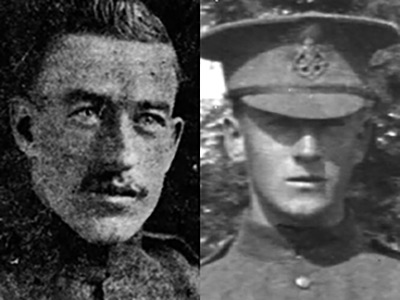
With newspaper rumours of an imminent armistice circulating for months, Clara must have had high hopes in October of 1918, that after four years away at war, she would see her boys again soon. That dream was not to be realized. Fred was killed in action on the Western Front on October 10, just four weeks before peace was declared.
Henry, who had never really recovered from his appendicitis, continued to decline, developing pleurisy and a massive pelvic abscess. On January 13, 1919, while most Canadian boys were boarding troop ships for home, Sergeant Charles Henry McAuley died alone in Bassingstoke Hospital, Hampshire. Two months later, crushed and broken by the deaths of her two sons, Clara died in her Rosemount home at the age of just 47.
The Cummings Brothers
The Second World War was but 225 minutes old when Ellard, the son of James and Edith Cummings of 46 Spadina Avenue became just the second Allied serviceman to die in the war and the first Canadian. The first died a couple of hours before when he lost control of his aircraft near London.
Flying a lumbering Westland Wallace biplane, a target-towing aircraft, Cummings was proceeding north from Aberdeen, Scotland to a gunnery school near Inverness when he entered heavy cloud obscuring the tops of the Bennachie Hills, a low massif that rose from the rolling farmland of Aberdeenshire. The Wallace crashed into the craggy and fescue-covered slopes and both Cummings and his drogue winch operator were killed instantly.
James and Edith were just coming to grips with the possibility that Ellard might be in danger in the months ahead, when there was a knock at their door. The telegram they opened had to be an utter shock to them. Of the nearly 45,000 Canadian families that lost a son or daughter in the war, the Cummings family had the tragic honour of being the first. But that was not the totality of their sacrifice.

Ellard’s younger brother Ken (he had four brothers and one sister), inspired by his brother’s early departure from the war, joined the RCAF as soon as he turned 18 in November 1941. Like his lost brother, he trained as a pilot, and the age of just 20, he found himself the captain of a Handley Page Halifax bomber with 102 Squadron of the RAF. The weather over Europe was abysmal in late ‘43 and early 1944. Despite being with the squadron for five months, he had only taken his crew on six “ops” over enemy territory.
On the night of February 19-20, Cummings took off with his crew, bound for a raid on Bremen. A few hours later, nearing the target, his Halifax was hit by a night fighter or perhaps flak and he lost control. As the aircraft spiralled down, he ordered the crew to abandon the bomber. Only two men managed to get out of the aircraft in the chaotic descent. Ken Cummings, as aircraft captain, would have waited until all others in the front of the aircraft had left before bailing out. He never made it.
The Casey Brothers
After two weeks of embarkation leave in May, 1941, Sergeant pilot Raymond Casey of 43 Granville Avenue said goodbye to his mother Mary and stepped up into the car of the Ocean Limited in the dark train shed of Ottawa’s Union Station, bound for Halifax and was gone forever.
He wrote to her often throughout the next year as he trained on ever-heavier aircraft and then joined 35 Squadron of Bomber Command as the captain of a 4-engine Halifax bomber crew — an extraordinary responsibility for a 20-year-old. In July of 1942, he piloted his Halifax on a night raid to Duisberg, Germany. Over the city he was hit by flak and the port outer engine was damaged. Unable to feather the engine (stop the propeller from windmilling), the bomber was difficult to control, yet he managed to get it back over England where he ordered everyone to bail out. Along with the flight engineer, he tried to bring the aircraft down safely but finally lost control and the Halifax dove vertically into the ground killing them both instantly. Mary received her telegram two days later.

His younger brother John, a farm labourer at the Central Experimental Farm, inspired by his brother, enlisted when he turned 18 the following year. He was thought to be very young but suitable officer material. Upon his graduation from Bombing and Gunnery School he was made a Pilot Officer. In April, 1944, he traveled home for two weeks of embarkation leave and, on April 21, left from the very same train platform as his brother did. His mother’s trepidation as he pulled out from the station was now very much justified.
John completed his gunnery training in Great Britain and joined the crew of a 431 Squadron (now the Snowbirds) Lancaster. Nearly a year would go by with cheerful letters from John. The war was clearly winding down with the Allies pushing into Germany from the west and east. Mary’s hopes were for his safe return were growing, but German flak was as devasting as ever and on the night of March 31, five weeks short of VE day, John’s Lancaster was blown out of the night sky south of Hamburg, Germany. His remains were recovered from the wreckage by German authorities, buried locally and eventually removed to the large Reichswald Forest War Cemetery near the Dutch border.
One can only imagine what memories came alive in her heart when, eight years later, she walked alone in front of thousands at the National War Memorial up the stairs to place a wreath as the nation’s Silver Cross Mother, representing all mothers who sacrificed their sons and daughters in war.
The Smiths
Like many the mothers of the men who volunteered for service in the two world wars, Amy (Wright) Smith of Westboro was already a widow and raising her family on her own — four daughters and five sons. Her husband John, an Oxford trained engineer was the former Dominion Fire Commissioner. They lived at 68 Helena Street at the time. At least two of her sons Donald (Donnie) and Leonard (Lennie) enlisted in the Royal Canadian Air Force at the outset of the war. It’s possible other children enlisted, but those records are not readily available to the author.
Lennie, the younger of the two, trained as a pilot in Canada, went overseas and soon found himself as the captain of a Vickers Wellington bomber crew with 115 Squadron of the RAF. Shortly after joining the squadron on the night of October 6, 1942, his Wellington was hit by flak detonating his bomb load in flight over the town of Uelsen Bentheim, Germany. The entire crew died instantly. Only fragments of the crew were recovered, and Lennie was identified only by his identity disc. Amy received the first of her two “regret to Inform you” telegrams at her new residence at 480 Cole Avenue.
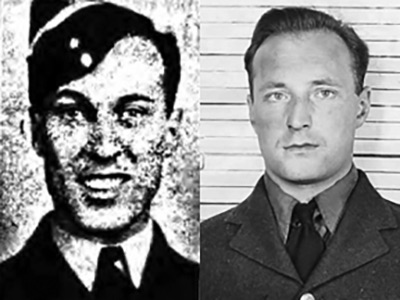
Older brother Donnie, a file clerk in the Department of Finance, had joined the air force six months before Lennie was killed and was well on his way to be trained as a navigator, one of the most difficult jobs among bomber air crew. He embarked a troopship for England on August 25, 1943, for further training on the Wellington bomber at No. 26 Operational Training Unit.
On the night of March 23, Lennie and his crew were almost finished a lengthy nighttime cross country training flight, when inexplicably, the pilots lost control and the aircraft dived into the ground “from a considerable height.” The station commander wrote to Amy, assuring her that he and his crewmates were killed instantly and did not suffer, leaving her however to imagine the abject terror her beautiful boy endured as they fell from altitude. As was common practice in those days, he enclosed photographs of the funeral service and burial four days later. Parents often appreciated these mementos as they were likely never to visit the graves of their sons.
The Carruthers Brothers
In mid-February of 1942, the two Carruthers brothers of 278 Sherwood Drive spent a shared leave together in England. Carl, the older of the two, was a Flight Sergeant air gunner with 15 Squadron based out of RAF Wyton in Cambridgeshire and flying in the enormous Short Stirling heavy bomber. He had been with the unit for almost a year. His younger brother Ford, also an air gunner, had arrived in England at the end of 1941 and was then with No. 25 Operational Training Unit at RAF Finningly. Carl and Ford, sons of Orrin and Beulah (Ford) Carruthers, likely spent it in London, enjoying the sights and the nightclubs. They were a contrast in personalities. Carl was assessed in training as “Abrupt almost to the point of rudeness… excellent in character and habits… needs grooming and discipline” while the younger Ford was considered “well disciplined, smart in appearance, pleasing in manners”.
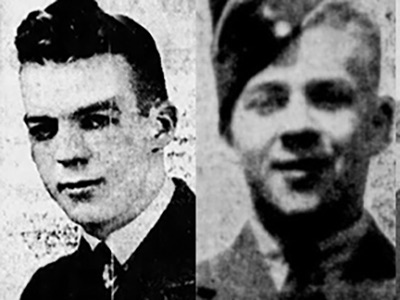
Following their leave, Ford took the train back to Yorkshire to continue training and Carl went back to the war. Not much later, on the night of March 9, on his second bombing operation since returning, Carl’s Stirling was hit by flak over Holland and the entire crew killed. By September of that year, Ford was on a crew with 12 Squadron, a Vickers Wellington medium bomber unit based at RAF Binbrook. Returning from a night operation to Duisberg, Germany on the night of the 6th, his Wellington was shot down over the North Sea, likely from flak along the coast of Holland. In less than six months, Beula and Orrin had lost two of their three sons.
The Angels of D-Day
Norman Angel, aged 36 and his brother Harold, who everyone called “Buster”, aged 30 were ancient by the standards of soldiers of the Second World War. Despite their age they were just private soldiers in the Cameron Highlanders of Ottawa. They were two of four brothers who had joined the army. Two others had returned to Ottawa, both suffering from prolonged illnesses. One of them, Charles, was a veteran of more than three years fighting in the First World War as well. Their mother was deceased in 1936 but their father Thomas, a First World War veteran and locomotive engineer was still alive. Despite this, in their Second World War service records both had listed their sister at 417 Athlone Avenue as their next of kin, though Norman was married to Mary Montpetit and they had three children in Iroquois, Ontario.
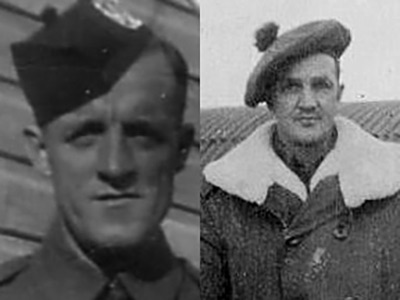
The two waded ashore with the Camerons on D-Day along with 14,000 other Canadians. Three days later, Harold went missing. For days, Norman searched the front where the Camerons were operating, but his brother was eventually confirmed killed on the June 9. Four weeks later, Norman himself was killed in action in Normandy. They came ashore together on D-Day, and now they lay buried in the same war cemetery in Calvados, France.
The Halls of Hinton Ave.
Warrant Officer Clement “Tubby” Hall and his brother Alfred were the two sons of Effie and Clement Hall of 420 Hinton Avenue. Both joined the RCAF in the Second World War. Tubby, the younger of the two was the second to enlist. One of his reference letters supplied upon his enlistment stated that “He belongs to a splendid family and is himself a clean, honest, energetic type of boy”. A recent graduate of Ottawa University he worked at various retail stores as a sales clerk to help offset his education costs. After he earned his pilot’s wings, he shipped out to Halifax to await a troopship to England. It was there, with just hours to go before boarding that he married a woman named Mildred McPhee, who did not disclose her marriage to his family or her employer for fear of losing her job. Unknown to Effie, who was the beneficiary of her son’s war gratuity cheque after his death, Mildred came out of the woodwork, laid claim and was granted the money, which Effie was forced to return, despite the fact that Clement had named her as beneficiary.
Tubby, one of Ottawa’s best known college athletes, was the captain of a Wellington bomber still on a training course at No. 12 Operational Training Unit at RAF Chipping Warden. A part of the course, he was required to join in actual operations over enemy-held territory. On the night of September 6, 1942, and with little combat experience, he was pilot in command of a Wellington bomber on an operation to Duisberg. His aircraft failed to return. He is buried in Rheinberg War Cemetery
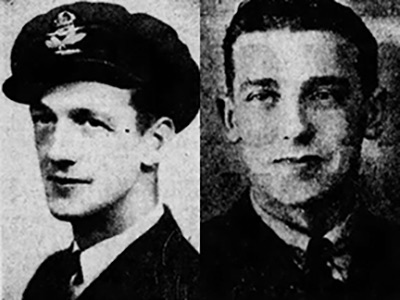
Effie’s oldest son, Alfred Hall, a draughtsman, was married in 1937 and had two daughters by the time he shipped overseas. He was trained as a wireless operator/air gunner and was assigned to 420 Squadron of the RCAF. On the night of April 30, 1944, his Halifax was part of a bombing raid on the rail yards at Somain, France, about 20 kilometres east of the site of Vimy Ridge. As his crew turned for home, they were hit by flak or a night fighter and went down in the English Channel. The entire crew was lost, but Hall’s body washed up six days later on the shore of the Somme River-Abbeville Canal estuary close to the village Le Hourdel, France. When he was buried in a local war cemetery his wife would have had the right to decide on the epitaph on his headstone which reads “Now flying with a better squadron in a better world”
The Kelly Brothers
John Lomer Kelly of 128 Breezehill Avenue was a cub reporter for the Ottawa Journal daily newspaper. His father, a detective with the Ottawa Police Department, had died before the war and his mother Mary Kelly took on sole responsibility for raising her four sons and daughter. Her oldest, Flying Officer Harold Kelly, was a navigation instructor at Portage la Prairie and her youngest, Richard, had yet to enlist.
John earned his pilot brevet on single engine aircraft and following embarkation leave with his family, he sailed by troopship from Halifax to Bournemouth, England. After a refresher flying course, he was posted to No. 8 Operational Training Squadron, where he would undergo training on the Supermarine Spitfire in the photo-reconnaissance role — a dream posting for a young pilot. No. 8 was located on the northeast coast of Scotland at RAF Fraserburgh.
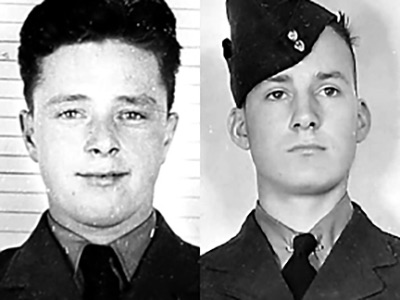
During one of his training sorties on November 19, 1944, he lost control of his Spitfire and crashed into the North Sea east of Aberdeenshire. His body was never recovered, and his only memorial is his name carved in the granite panels of the Runnymede Memorial along with the names of more than 20,000 Commonwealth airmen lost on operations in Europe with no known grave. Around the time of his death, younger brother Richard enlisted in the RCAF. The war in Europe was winding down, but there seemed no end to the war in the Pacific. It was known that when the war against the Germans ended, many would be shipped to the Pacific, so Mary Kelly must have been troubled by his enlistment.
During his training, Japan surrendered unconditionally, and Mary felt her two remaining sons in the RCAF would now be safe. This was also not to be. During his training, he contracted tuberculosis, and was admitted to the Royal Ottawa Sanatorium (the present-day Royal Ottawa Mental Health Centre), where he died just two days before Christmas, 1945.
